Belarus Tour Guide: Ideas for Your Trip!
Smorgon, a place of Napoleon’s bivouac, WWI ‘dead town’
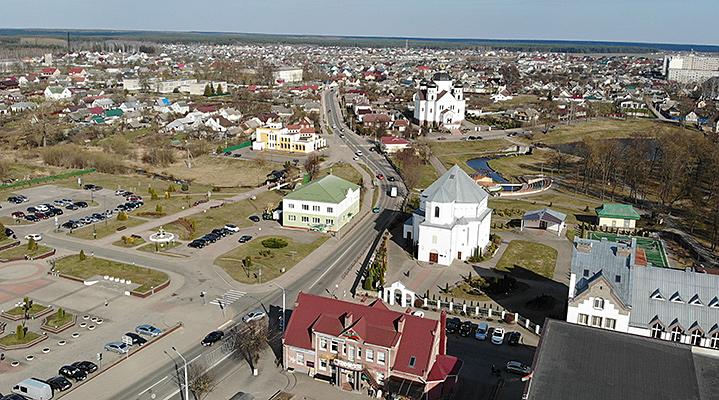
On the banks of the Oksna River (the left tributary of the Vilia) and the Gervyatka flowing into it, in the north-west of Belarus stands the town of Smorgon. It has been known since the early 16th century and has been owned by the influential families of Zenovichis, Radziwills, Przezdzieckis. In the 17th century, it earned fame for an unusual educational institution - "a bear academy", the most famous bear training school not only in the Belarusian lands but also in Europe... In 1812, Napoleon had its camp in a forest near Smorgon, the last one on the territory of the Russian Empire. Having burned the banners, abandoning his marshals and the surviving guardsmen, Bonaparte fled to Paris. A century later, during the First World War, Smorgon became an epitome of true heroism, holding out for 810 (!!!) days, and incredible tragedy, becoming “a dead town”. Only about 150 inhabitants returned to the town after the war.
There is no reliable information as to the origin of the name of Smorgon. Several versions have survived to this day. Local historians insist on the combination of two words "morg" (an area unit of approximately 0.71 hectares) and "goni" (arable land). Presumably, the Zenovichis, the first owners of the town, gave their peasants plots of land the size of one morg – "s morg goni". Another legend tells that first inhabitants of the settlement used uprooted stubs to brew turpentine ("smar" or "smur"). Therefore, their profession was called "smarogons" or "smurgons".
The Belarusian toponymist V. Zhuchkevich traced back the name of the town to the Baltic word smurgo – a slob, a slacker, an apprentice. Later, scholars put forward the idea of a nickname Smorg derived from smurgo. The Baltic form Smurgainys (Smurgoini) can be coined from the words smurgis – "a punk", smurgas - "icicle from the roof, a snot nose", smurgti - "sprinkling, drizzling". The most unusual version was proposed by scholar A. Rogalev, who believed that the name came from an older hydronym where the parts of Smor- and -gon were associated with the ethnonym Kimery [Cimmerians] and the Iranian words kan, khan, khon – "a source"…
Smorgon has been the venue of important events in the world history but, unfortunately, too often they were associated with wars. Moreover, the town more than once hosted the commanders-in-chief of the armies. In June 1655, Smorgon was the place of the headquarters of Tsar Alexei Mikhailovich. During the Northern War, Charles XII chose Smorgon for his main quarters in February-March 1708. During the retreat of the French army, Napoleon arrived in Smorgon on 5 December 1812. Here he dictated his last order for the army, held a meeting with the generals, turned over the command to Marshal Murat and left for Paris in the evening. At the end of December, it was Commander-in-Chief Mikhail Kutuzov who set his camp in Smorgon…
During the First World War, Smorgon became the only town on the front from the Baltic to the Black Sea which the Russian army defended for 810 long days, an unprecedented case in history at that time.
The Second World War brought many more tragedies and caused countless victims. It took decades for the town to recover.
Today, Smorgon is interesting to tourists as a place of important events of European and world history, especially military history. Despite the devastating battles of various centuries, the town and the surrounding area have preserved part of the unique heritage, which is still impressive.
St. Michael the Archangel Church

St. Michael the Archangel Church in Smorgon is the most famous of the few surviving Renaissance monuments in Belarus. Its fate was unusual. When the Reformation made its way to the Belarusian lands in the 16th century, they practically did not build new churches but repurposed Catholic ones. However, the temple in Smorgon was an exception. It was originally built as a Calvinist church (1606 – 1612), without an altar part, in accordance with the modest requirements of Calvinist traditions. It was this reformation movement that became the most common in the Grand Duchy of Lithuania. The donor of the church was the influential statesman and Calvinist Krysztof Zenovich.
The building looked impressive and formidable: the walls were three meters thick, with windows high above the ground. The temple had an attic, typical of the Renaissance architecture. Initially, a four-tiered belfry tower towered above the entrance, but in the 19th century it was reduced by two floors.
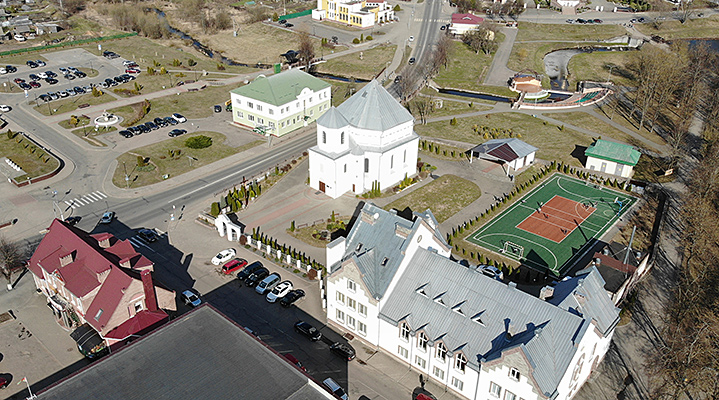
By the middle of the 17th century, the Catholic Church regained its positions, so the church in Smorgon became a Roman Catholic church. During its time, the building served as an Orthodox church and in the Soviet years as a shop and a museum hall. In the basement of the church there is the tomb of the Zenovich family.
Address: 1 Petra Balysha Street
Cathedral of the Transfiguration of the Lord

The architectural dominant of Smorgon - the Cathedral of the Transfiguration of the Lord - stands on a hill near the Oksna River. It was built on the site of an old Orthodox church, which, unfortunately, was destroyed in the Soviet period. Construction of the church designed by architect Anatoly Shabalin began in 1989 and lasted two decades. The temple was consecrated in 2009 as part of the Belarusian Written Language Day celebrations in the town.
The five-domed Cathedral of the Transfiguration of the Lord became the largest building in the town. It is about 40m high, 35m long and about 28m wide. The church can accommodate up to 1,500 people.
Address: 3 Krasnoarmeyskaya Street
WWI memorial complex

"You have to fight near Smorgon to understand what a war really is,” soldiers of the First World War used to say. Indeed, it was the place of the bloodiest and most brutal events of that terrible war. Being on the line of the Eastern Front, the town held out for 810 days. The town was turned into ruins, with almost no residents. The newspapers of that time called Smorgon ‘a dead town’. Later, the fierce battles near Smorgon of 1915 will be compared with Stalingrad during the Second World War.
In the vicinity of Smorgon in 1916, the Germans used toxic substances that killed thousands of soldiers and officers, which was the first ever case in the Belarusian lands. The Germans used mustard gas in violation of the decision by the Hague Conference to prohibit toxic substances, which Germany was a signatory to. However, the Germans argued that the conference banned shells with asphyxiating and harmful gases but not cylinders...
Young writers Mikhail Zoshchenko and Valentin Kataev fought near Smorgon. Countess Alexandra Tolstaya, the youngest daughter of Leo Tolstoy, was in charge of a large front-line hospital set up in the former Oginskis estate in Zalesie near the town. She left moving memoirs of the war. A radiotelegraph station at the front was commanded by ensign Sergei Vavilov, an optical physicist, the future president of the USSR Academy of Sciences.

Taking part in the battles near Smorgon was the Women’s Battalion of Death, the first all-female combat unit in the history of the Russian army. It was led by Maria Bochkareva, one of Russia’s first female officers.
In March 1916 the supreme commander-in-chief arrived at the frontline near Smorgon. Emperor Nicholas II, together with the heir to the throne Tsarevich Alexei inspected the Volyn regiment in Zalesie. Their visit helped boost morale of the town’s defenders.
...The German composer Hermann Blume who lost his right hand in the battles near Smorgon wrote the Smorgon March that was later included in the Collection of Military Marches of the Bundeswehr.

The tragic and incredibly heroic history of Smorgon inspired the creation of Belarus’ largest memorial complex commemorating the heroes and victims of the First World War. It was unveiled in 2014 marking the 100th anniversary of the beginning of the war that changed the history of humankind. Moreover, the complex in Smorgon became the first memorial of such a scale in the post-Soviet space. For many decades, the Great War was neither studied nor immortalized properly.
Smorgon, dubbed as the Belarusian Verdun, would get the title of the hero town in the First World War, if such titles were given at that time. Today the town is like an open-air museum with fortifications and trenches, and most importantly, mass graves and numerous soldiers’ burial sites...
The memorial complex created in the Victory Park consists of several sculptural compositions: Refugees, Soldiers of the First World War and The Winged Genius of Soldier’s Glory. A chapel was built on the territory of the memorial complex and a Stone of Memory was installed with a message to descendants: “A war brings nothing but destruction, grief, blood and death. Our sacred duty is to remember this”. The St. George Cross was mounted at the entrance to the memorial complex.
Address: Victory Park
Monument to the Bear Academy
Visitors to the municipal park can see a striking sculptural composition Bear Academy installed near the St. Michael the Archangel Church. The composition depicts buffoons and a bear, the same kind as you see on Smorgon’s emblem. There was a bear training facility in the town in the 17th-19th centuries. The Bear Academy had its heyday in the 18th century under Prince Karol Stanislaw Radziwill known by his sobriquet Panie Kochanku (My Beloved Sir) that came from his favorite form of informal addressing to others. They say that in his Nesvizh residence, even in the summer he rode a sleigh on roads covered with ... salt.
Trained bears from Smorgon were known far beyond the Grand Duchy of Lithuania. They performed at fairs in Prussia, Schleswig, Bavaria, Alsace, as well as at all entertainment events at home. Four-legged artists showed sophisticated tricks - they bowed, danced, marched, looked in the mirror, fulfilled commands of buffoons.
Tamers often used rather cruel methods to train bears. In spring, bear cubs were pulled out of their dens in the surrounding forests and brought to the academy. The animals were placed into cages standing above large piles of burning logs. Special boots were put on the hind legs of the animals while the front legs remained unprotected. As the copper-made bottom of the cage became hot the bears would be forced onto their hind legs and then begin lifting each paw in turn while a drum or other music was played. A few months later the bear came to associate music with the pain in its feet. Thus, whenever the bear heard the sound of a tambourine or another instrument, it would begin to “dance”.
The Bear Academy in Smorgon ceased to exist in the late 1860s, but it has been remembered to this very day. In 2014, a monument to bear artists was unveiled in the town. By the way, the bear has become not only a symbol of Smorgon and an element of the emblem, but an important part of the local culture and way of life. For example, a bear is depicted on local ice cream. In the 17th-19th centuries, dancing bears served as an inspiration for a signature dish of Smorgon - round ckracknels. Special dough sticks were baked for four-legged sweet teeth. Later these sticks were rounded off and the recipe was modified to suit human taste. The addition of poppy seeds, honey and even wine greatly improved the flavor of the ckracknels and made them a favorite treat among locals. Smorgon delicacy was called abvaranki, abarzhanki and smargonki.
Smorgon Local History Museum
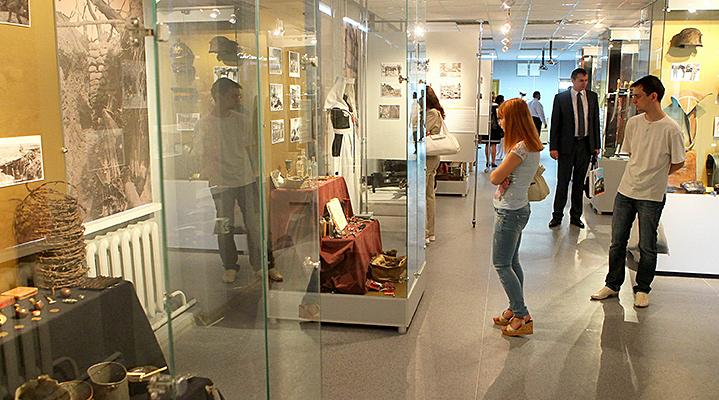
The Smorgon Local History Museum keeps over 11,000 items in the main holdings. These are collections of paintings, drawings, arts and crafts, documents, printed publications, coins, paper currency, medals and other decorations, archaeological finds, weapons, ancient technology items, household items, photos, sculptures and items related to natural history.
Opened in 1984, the museum was initially housed in the former Calvinist church, but decades later it moved to its permanent location in the new building. The museum has four halls. The first hall “Krevo in the 14th-17th centuries” is dedicated to the history of the town of Krevo and Krevo Castle. The hall “Town of Fairs” gives a glimpse into the history of Smorgon in the 16th-19th century, it tells visitors about the owners of the town - the Zenovichis, the Radziwills, and the Przezdzieckis, the Smorgon Fair and the famous Bear Academy. The hall “Light and darkness: 20th century” shows how local residents lived in peacetime and survived during the hardest years of the wars; the exhibits on display show the tragedy and heroism of the people during the First World War, the strength of the generations that won the Great Patriotic War ... The hall “We are all in love with our land” is dedicated to talented people who made the Smorgon land proud - famous sculptors, artists, musicians, writers, artisans.
The museum offers fascinating tours of exhibitions and the permanent exposition, as well as sightseeing tours around the town and the district, including theatrical tours.
Address: 23 Kutuzova Street
Rock Garden
Stone sculptures made by young sculptors at one of plein air sessions were donated to the town and brought to the central park of Smorgon. Some are abstract and non-realistic, others are recognizable and concrete. Walking through the park, everyone can appreciate the creative ideas of the fledging artists.
Monument to Frantishek Bogushevich
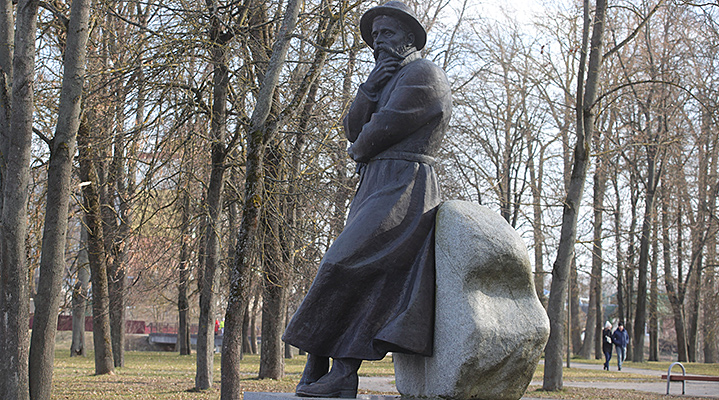
In the central park, not far from the Cathedral of the Transfiguration, there is a monument to famous Smorgon native Frantishek Bogushevich, an outstanding national poet, one of the founders of the new Belarusian literature. This bronze figure of about three and a half meters high seems to invite passers-by to stop for a while to think and read. The author of the iconic collections “Dudka Belarusskaya” and “Smyk Belarusskі” is depicted in traditional national dress - a long overcoat with a belt and a straw hat. The poet holds a book in his hands. The plaque on the pedestal bears Bogushevich's most famous quote: “Our nation will stay alive as long as our language stays alive.”
The monument, designed 20 years before it was implemented, was authored by architect Evgeny Mitko and sculptors Lev and Sergei Gumilevsky, the well-known creative duo of father and son.
Sightseeing near Smorgon
Frantishek Bogushevich's Museum Estate in Kushlyany

Kushlyany, Frantishek Bogushevich’s ancestral home, is situated near the same-name village, 18km from Smorgon. Surrounded by century-old oaks the estate was the place where the poet spent the last years of his life. The restored house has been dedicated as a museum (a branch of the State Museum of the History of Belarusian Literature). The interior of the house recreates the atmosphere of the late 19th century, with the study and living room reproduced with perfect accuracy. The museum keeps Bogushevich's first poetry collections, documents and personal photos.
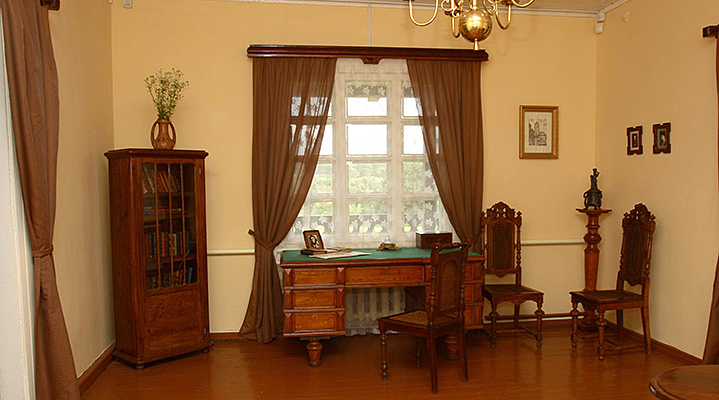
Not far from Kushlyany there is the village of Zhuprany, which also has connections to the famous writer. The local people say that Frantishek Bogushevich made a big personal contribution to the construction of the local landmark - the neo-Gothic St. Peter and Paul Church, built in 1875. There is a memorial plaque with the poet's portrait on the church wall. Next to the church there is a grave of Frantishek Bogushevich.
Krevo Castle
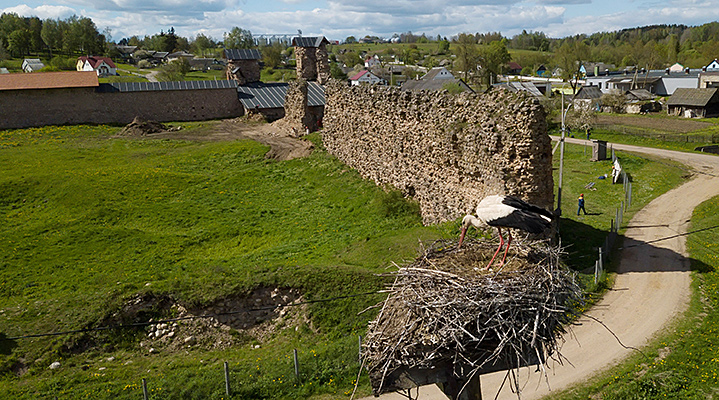
The castle-fortress has seen a lot of important events, legendary meetings and insidious intrigues. It was built at the confluence of the Krevyanka and Shlyakhtyanka rivers in the late 13th - early 14th centuries during the reign of Grand Duke Hiedymin. Later Hiedymin's son, Alhierd, lived and ruled here. In 1385 the Union of Krevo was signed in the castle by Dukes Vitaut and Yahaila, a step that marked the beginning of the unification of the Belarusian and Polish lands. Three years before Yahaila’s uncle Keistut, the Duke of the Grand Duchy of Lithuania, was imprisoned and strangled in the tower following Yahaila’s order. Keistut's son Vitaut, who was kept as a prisoners in the dungeons of the castle then, managed to escape, dressed as a servant…
Over more than seven centuries of its existence the castle has been a witness to many wars that swept across the Belarusian land. The devastating First World War left the castle in ruins, which, nevertheless, still attract many tourists today.

In 2016, work began on the conservation and partial restoration of the castle walls, and in July 2021 it began to receive visitors. After restoration Princely Tower will house a museum exhibition with artifacts found during the excavations in Krevo Castle. Fragments of ancient frescoes were found during the conservation of the basement under Princely Tower.
In 2022, a watchtower was reconstructed next to Krevo Castle on Yuriev Hill. In the times of the Grand Duchy of Lithuania similar constructions were signaling objects. Krevo Castle was of great defensive value and was a part of the general line of fortifications with Lida and Novogrudok. In Krevo Archeologists unearthed a part of the foundation of the 14th century, on which a stylized wooden tower was built. A quarter of this foundation became an exposition inside the structure. An internal staircase leads up to the nine-meter tower top. The observation deck offers a beautiful view of the castle and its surroundings.
Location: Krevo agro-town, Smorgon District
Michal Kleofas Oginski's Museum Estate in Zalesie

Zalesie settlement dates back to late 16th century. In the 17th century it became the property of the Oginski family who built a beautiful estate which became known as “Northern Athens”, “Estate of Muses” far beyond its borders. Michal Kleofas Oginski, an influential diplomat, politician, gifted musician and composer, and the author of the famous polonaise Farewell to the Motherland, spent 20 years of his life (1802-1822) there.
Today the restored estate attracts visitors with a rich exposition and a cozy creative atmosphere. Visitors can learn a lot of interesting things about the estate from the guides dressed as the relatives and friends of Michal Kleofas Oginski - daughters Amelia and Emma, son Ireneusz, secretary Leonard Khodko.
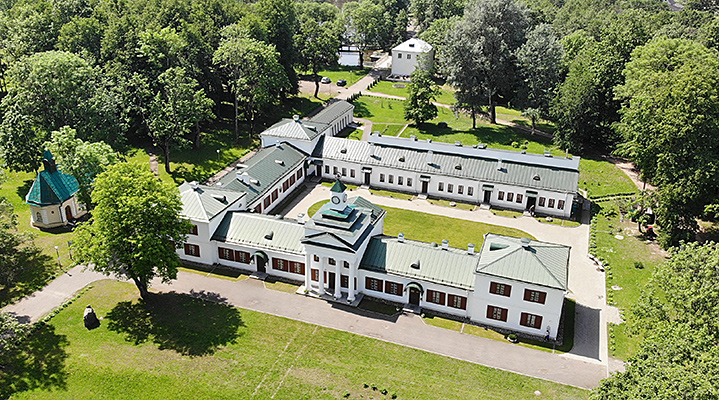
Owner of the estate Michal Kleofas Oginski was a very talented composer, although he considered himself an amateur. He wrote about 70 works, including waltzes, mazurkas, gallops, minuets, and quadrilles. His magnificent polonaise Farewell to the Motherland, which was originally titled A Minor No 13, was written in Zalesie. However, even before he came to the estate, Oginski's ballroom dances gained popularity not only in the former Polish-Lithuanian Commonwealth, but all over Europe. At the estate near Smorgon, the owner often arranged wonderful musical evenings which were attended by his family members and other guests.
Today visitors of the museum-estate can walk through the halls and see an exposition about the life and work of Michal Kleofas Oginski, take a look at the greenhouse with exotic plants, which could be found at the Oginski estate in the 19th century, and take a walk through a large picturesque park. Today, Zalesie hosts numerous events - scientific conferences, balls, 19th century dance workshops, classical music concerts, and performances.
Address: the agro-town of Zalesie, Smorgon District
Church of Mother of God of the Rosary in Soly

The town of Soly near Smorgon has gone down in history as the place where at the end of World War I the Russians and Germans signed the first armistice agreement that effectively ended the hostilities on the Eastern Front. It happened on 23 November 1917.
In the postwar years, the Catholic Church of the Mother of God of the Rosary, built in 1926-1934, became a majestic landmark of the town. The asymmetrical and yet very graceful church in Art Nouveau style was designed by architect A. Dubanevich. The residents of Soly and the neighboring villages took part in its construction.


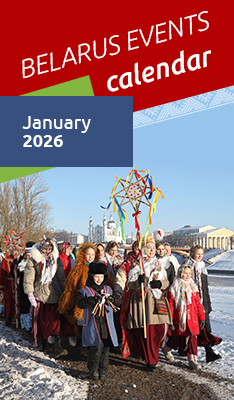




 print version
print version make home page
make home page add to bookmarks
add to bookmarks
